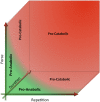Occupational Activities: Factors That Tip the Balance From Bone Accrual to Bone Loss
- PMID: 32004169
- PMCID: PMC7077966
- DOI: 10.1249/JES.0000000000000217
Occupational Activities: Factors That Tip the Balance From Bone Accrual to Bone Loss
Abstract
It is commonly assumed that beneficial adaptations in bone occur with vigorous exercise, yet any adaptive re/modeling in bone undergoing persistent overloading can be counteracted by superimposed inflammatory, compressive, and tensile loading-induced damage responses above thresholds of tissue fatigue failure and repair. This leads to a tenuous balance between achieving bone accrual and loss.
Figures



Similar articles
-
Scl-Ab reverts pro-osteoclastogenic signalling and resorption in estrogen deficient osteocytes.BMC Mol Cell Biol. 2020 Nov 4;21(1):78. doi: 10.1186/s12860-020-00322-w. BMC Mol Cell Biol. 2020. PMID: 33148174 Free PMC article.
-
Osteocyte signaling in bone.Curr Osteoporos Rep. 2012 Jun;10(2):118-25. doi: 10.1007/s11914-012-0105-4. Curr Osteoporos Rep. 2012. PMID: 22552701 Free PMC article. Review.
-
Osteocyte network; a negative regulatory system for bone mass augmented by the induction of Rankl in osteoblasts and Sost in osteocytes at unloading.PLoS One. 2012;7(6):e40143. doi: 10.1371/journal.pone.0040143. Epub 2012 Jun 29. PLoS One. 2012. PMID: 22768243 Free PMC article.
-
Osteocyte regulation of bone mineral: a little give and take.Osteoporos Int. 2012 Aug;23(8):2067-79. doi: 10.1007/s00198-012-1915-z. Osteoporos Int. 2012. PMID: 22302104 Review.
-
PTHrP-Derived Peptides Restore Bone Mass and Strength in Diabetic Mice: Additive Effect of Mechanical Loading.J Bone Miner Res. 2017 Mar;32(3):486-497. doi: 10.1002/jbmr.3007. Epub 2016 Oct 24. J Bone Miner Res. 2017. PMID: 27683064
Cited by
-
Manual Therapy Facilitates Homeostatic Adaptation to Bone Microstructural Declines Induced by a Rat Model of Repetitive Forceful Task.Int J Mol Sci. 2022 Jun 13;23(12):6586. doi: 10.3390/ijms23126586. Int J Mol Sci. 2022. PMID: 35743030 Free PMC article.
-
Mechanical regulation of bone remodeling.Bone Res. 2022 Feb 18;10(1):16. doi: 10.1038/s41413-022-00190-4. Bone Res. 2022. PMID: 35181672 Free PMC article. Review.
-
Blocking CCN2 Reduces Established Bone Loss Induced by Prolonged Intense Loading by Increasing Osteoblast Activity in Rats.JBMR Plus. 2023 Jun 16;7(9):e10783. doi: 10.1002/jbm4.10783. eCollection 2023 Sep. JBMR Plus. 2023. PMID: 37701153 Free PMC article.
-
Association between Musculoskeletal Pain and Bone Turnover Markers in Long-Term Pb-Exposed Workers.J Res Health Sci. 2021 Jul 6;21(3):e00522. doi: 10.34172/jrhs.2021.55. J Res Health Sci. 2021. PMID: 34698656 Free PMC article.
References
-
- Wohl GR, Boyd SK, Judex S, Zernicke RF. Functional adaptation of bone to exercise and injury. J. Sci. Med. Sport. 2000; 3(3):313–24. - PubMed
-
- Romano A, Vigna L, Belluigi V, et al. Shift work and serum 25-OH vitamin D status among factory workers in northern Italy: cross-sectional study. Chronobiol. Int. 2015; 32(6):842–7. - PubMed
Publication types
MeSH terms
Substances
Grants and funding
LinkOut - more resources
Full Text Sources

